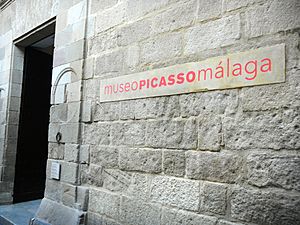Museo Picasso Málaga facts for kids
 |
|
| Established | 2003 |
|---|---|
| Location | Málaga, Spain |
| Visitors | 391.319 (2011) |
The Museo Picasso Málaga is a museum in Málaga, Spain. This is the city where the famous artist Pablo Ruiz Picasso was born. The museum opened in 2003 inside the beautiful Buenavista Palace. It holds 285 artworks that were given by members of Picasso's own family.
In 2009, two foundations joined together to run the museum. One foundation owned the art collection, and the other managed the museum itself. The new combined foundation is called the "Museo Picasso Málaga Foundation. The Paul, Christine and Bernard Ruiz Picasso Legacy."
Contents
Discovering Picasso's Art
The idea for a Picasso museum in his hometown was first talked about way back in 1953. However, it took many years for the dream to come true.
How the Museum Started
Christine Ruiz-Picasso, who was married to Picasso's oldest son, helped make the museum happen. She worked with Málaga to put on art shows in the 1990s. These shows helped bring back the idea of a big Picasso museum in the city. The museum finally opened its doors on October 17, 2003. The King and Queen of Spain were there for the special opening!
The Art Collection
Christine Ruiz-Picasso gave 133 artworks to the museum. These included paintings, sculptures, drawings, and ceramic pieces. Her son, Bernard Ruiz-Picasso, who is Picasso's grandson, also donated 22 more artworks. In total, the museum started with 155 works from the family.
The art in the museum shows Picasso's journey as an artist. You can see his early school studies, his famous cubism style, and even his later works where he re-imagined art by old masters. Many other artworks are also on loan to the museum for long periods. The museum also has a library with over 800 books about Picasso.
The Museum Building
The museum is located in the historic Buenavista Palace. This palace was built a long time ago, in the early 1500s. It was built on top of an even older palace from the Nasrid dynasty. You can still see parts of that ancient palace today!
From Palace to Museum
The Buenavista Palace was named a special national monument in 1939. It used to be a fine arts museum from 1961 to 1997. Then, it was bought with the plan to turn it into the Picasso museum. Other buildings next to the palace were also fixed up or built to create the museum we see today. The museum includes 18 old houses from the city's former Jewish quarter.
The entire museum, including the palace and other buildings, covers a huge area. The designers made sure to use lots of natural light, especially through skylights.
Building the Modern Museum
Turning the old palace into a modern museum was a big job. American architect Richard Gluckman led the project. The team had to get permission to change or remove some existing buildings.
During the building work, amazing discoveries were made underground! They found parts of an ancient city wall and towers from the Phoenicians. They also found a Roman factory that made garum, a fish sauce. And, of course, they found parts of the older Nasrid palace. Because of these finds, the museum's basement is like an archaeological museum itself. You can even see these old ruins through clear panels in the floor!
Making a modern museum inside a 450-year-old palace was tricky. Things like keeping the temperature and humidity just right for the art were hard. The architects had to hide air conditioning ducts and wires carefully so they wouldn't damage the old walls. They even made air vents look like old marble designs to blend in. This way, modern technology was hidden inside the ancient building.
Picasso's Connection to the Area
The Museo Picasso Málaga is very close to the Plaza de la Merced, where Picasso was born. It's also on Calle San Agustín, a street that was important to Picasso and his family.
Even though Picasso moved away from Málaga when he was 10, he went to nursery school on Calle San Agustín. His father, José Ruiz Picasso, was in charge of the city museum, which was also on that street. Picasso's father even had his own painting studio there, where young Picasso created some of his very first artworks. From the museum's new staircases, you can even see the tower of the Santiago church, where Picasso was baptized as a baby.
See also
 In Spanish: Museo Picasso Málaga para niños
In Spanish: Museo Picasso Málaga para niños
- Fundación Picasso, which runs another smaller Picasso museum in Málaga
- List of museums in Spain
- List of single-artist museums
- Musée Picasso (Paris)
- Museu Picasso (Barcelona)

